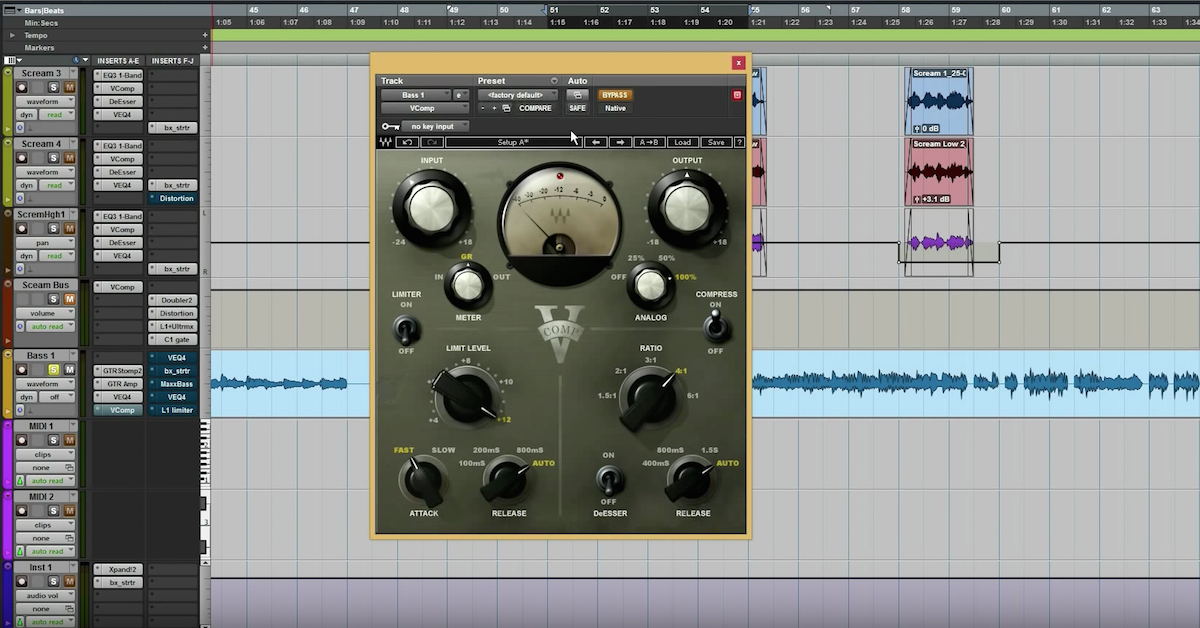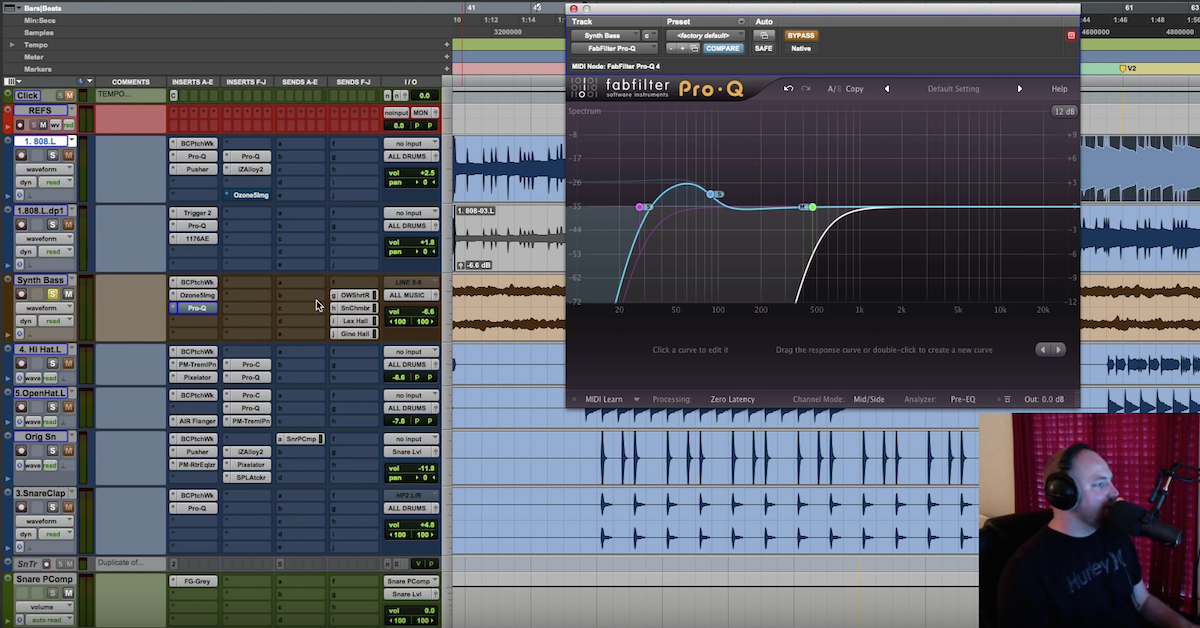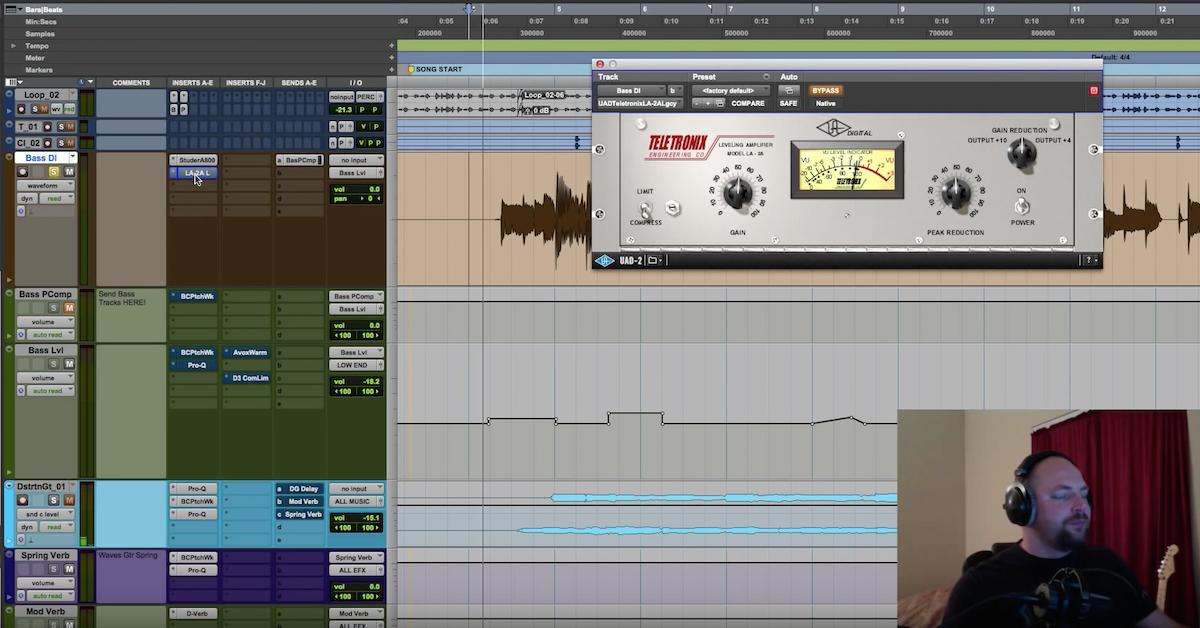Mixing Bass Guitar Amp Tones and Fixing Phase Relationship with DI
We’ve got a sweet announcement, we’ve released “mixing acoustic pop,” got the song chosen. You guys will see me doing the mixing acoustic series, and I took that same song that was the acoustic version that I created from the radio version. Well, I finally mixed the radio version and it’s out. That training course is going to be a complete walk-through from A to Z, everything I did, starting with the kick and ending with the stereo buss and kind of a mastering pattern there.
So, go check that out at mixingacoustic.com, or follow the link in the video, probably below as well.
We’re going to pull open – I’m going to give you a little teaser of kind of how I’ve mixed the bass guitar, and some things I did to kind of prepare in production, and then a little bit of the mixing technique that I used for the bass guitar, and then give you one more option as well that’s one that I didn’t use.
Diving right in, I’m going to play the bass the way that it was originally sent to me from a friend of a friend who recorded this bass, just straight into your average M-Box or something like that. Nothing to it, no compression, no EQ. Plugged it in and sent it to me.
[bass guitar]
Okay. So nothing fancy, nothing crazy, and I’m not going to go over this stuff just yet. This is in the course, but then the after the processing.
[bass guitar with plug-ins]
A little more bottom, a little bit more clarity. The lows are compressed with a side-chain compressor chained to the kick, keeping that on top, and hitting that a little bit. Just some other stuff, we’ll get into that later or check out the course, for sure.
But what I want to talk to you about today is blending an amp tone. So he just gave me the M-Box, there’s no amp, and a lot of times guys, when they do send me a DI and a real amp that they’ve mic’d, I’ll listen to it, I’ll see what I think, but I’m getting great results from some of these new plug-ins. One of those is the Softube Bass Amp Room. There’s a native version of this from Softube, and I’ve also got the UAD version here. This is the preset I picked, but let’s go through them.
Typically, what I do is I put the two together, and then I’ll boost the amp room so I get a lot of that, and them I’m going to listen between the two and see what the bass amp tone is doing. So let’s take a listen to what this one’s got going on.
[bass DI + amp]
Yeah, so clean mid, that’s the one that really jumped out at me. When I’m listening for a bass amp tone to emulate and blend with my DI, a lot of times what I’m listening for is how the mid-range reacts. What is the mid-range doing from about 200-300 and up, and say that we like that, the next step for me is actually to come over here and instantiate the Pro-Q 2, and I’m just going to bring up 250 for now. Let’s solo this.
[bass amp with high-pass filter]
Okay. I want a little bit more volume now that I’ve hit some of those, let’s pull this guy up a bit.
[bass amp]
Okay. So that sounds pretty sweet. A little bit of string noise, some stuff that maybe we don’t need that’s way up there.
[bass amp]
So before the EQ…
[bass amp before EQ]
And after.
[bass amp after Pro-Q 2]
Okay, so I don’t mind what’s going on in the 140 region and up, but it would get a little bit crazy if we added in the lows and the subs from here that we’re mixing and controlling with the Pro-MB. We might just get too much of that, so for me, I’m going to take this guy down now, and I’m going to blend it in to taste.
[bass amp + DI]
Without it.
[bass DI]
Okay. So, I like what we’ve got going on there, but just because I want to make sure that we maintain a great phase relationship, or create a better phase relationship, I’m going to go in here and I’m going to instantiate the Sound Radix Auto-Align.
I’m going to pull this open, I’m going to set this guy to send. We’re going to detect delay and polarity, pull up a little bit of the noise floor there, then I’m going to do the same thing here at the end of the processing. We’re going to receive on channel one – so we’re sending from the DI, we’re receiving it on the bass amp. We’re going to detect, and we’re going to hit play.
[bass guitar]
Alright. So it’s delayed that by 220 samples. Now let’s come out here to the end, and let’s hear something different.
Those are both the last plug-in on each of their chains. I’m going to come over here, and I’m going to hold Command+Option+Shift. It’s going to be just these two tracks, and I’m going to bypass it on both tracks at the same time. So I’m going to play it before, and then I’ll add it back in about half way.
[bass guitar plays, Auto-Align bypassed and re-enabled]
I’ll drop the amp, play that again, and blend it in.
[bass guitar]
Okay. Now, it doesn’t always make it better, or it doesn’t always make it so that it fits better within the track. So now that we’ve heard it by itself, I’m going to leave it in, and then we’re going to pull it out, and then you as the mixer can decide if you like the way that it’s affecting the lows. It may tighten up the lows, and help those to have a better relationship, but you may miss out on some of the mids, and I think we are going to be missing out on some of the mids that we just tried to create. So let’s take a listen, here’s with it in.
[bass guitar, Auto-Align enabled and bypassed]
So, it gets a little bit thinner. The mid-range comes out, I think in this case what I might do is then send both of these bass guitars with the phase relationship tightened up to what I call a bass level, and then apply another mid-range boost to the blend of those two guitars, and EQ that to taste. So that’s one way of looking at it, the Bass Amp Room from Softube and UAD.
Let’s take a look at the Saturn. I love this plug-in on bass from FabFilter. I’ve already got a preset here that I like, the Boutique. Let’s listen to this guy before and after.
[bass guitar]
We can back off the drive a little, or push it. Very nice. So that’s another cool one, and this one gives you multi-band parameters so you can control the drive for a band that you set. You can slide that around, you can see the band is changing at the top. The midrange, you can drop and get rid of whatever highs you don’t want, if you don’t want any of that extra nasty string noise, and you can drive the distortion independent.
You can have two different amps, you can see here this is “smooth amp,” and then the preset for this guy is “crunchy amp.” You can change that to any number of these, drive the distortion. This guy is just insane. I’m actually going to be starting to use this more, because I love the flexibility, and then you’ve got EQ, you’ve got bass, mid, treble, and presence for each band.
So anyways, you guys see that’s awesome, I don’t have to convince you of that. So there’s another way, Sansamp is always a good one. I think my default preset is “crunchy bass.”
[bass guitar, Sansamp enabled and disabled]
Without it, and back in.
So, there you go. A couple of things to pay attention to when you have a clean DI and want to create a little bit more of that mid-range character, like you’re working with a bass amp. You can blend the two to taste, don’t forget to check the phase relationship. If you don’t have Sound Radix Auto-Align, you can nudge those until they start to sound good and align the samples a little bit by hand.
The Saturn is incredible, the Sansamp is great, and I hope that gives you some thoughts, some ideas for working with bass, even when you do get an amp sent to you. Try comparing this to the amp that you’re given, and see which one serves the song better, because ultimately it’s about what’s going to make that mix the best for the client.
So thanks again for watching, don’t forget to check out “mixing acoustic pop” at mixingacoustic.com, or follow the link in the video. If you have any questions, send them to david@davidglennrecording.com.
Don’t forget to check out theproaudiofiles.com as well, and lastly, let me ask you if these have helped you, these videos, we do these free videos on the YouTube channel, please feel free to share these, send them to a buddy, a friend, a group of friends, post them in the groups, anything you can do to spread the word, we appreciate it, and I know that your friends will appreciate that too. So thanks again from David of davidglennrecording.com, and we’ll catch you on the next one.






